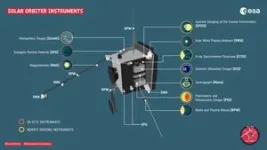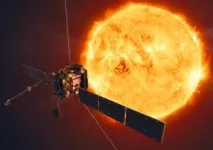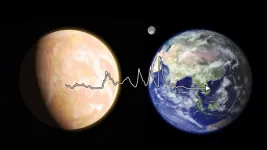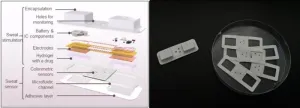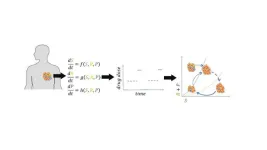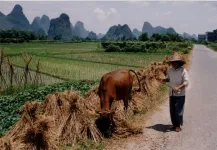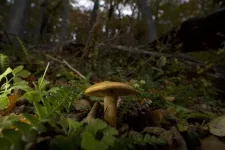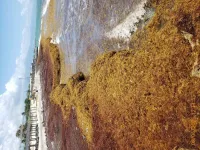(Press-News.org) Scientists have come a step closer to identifying the mysterious origins of the ‘slow’ solar wind, using data collected during the Solar Orbiter spacecraft’s first close journey to the Sun.
Solar wind, which can travel at hundreds of kilometres per second, has fascinated scientists for years, and new research published in Nature Astronomy, is finally shedding light on how it forms.
Solar wind describes the continuous outflow of charged plasma particles from the Sun into space – with wind travelling at over 500km per second known as ‘fast’ and under 500km per second described as ‘slow’.
When this wind hits the Earth’s atmosphere it can result in the stunning aurora we know as the Northern Lights. But when larger quantities of plasma are released, in the form of a coronal mass ejection, it can also be hazardous, causing significant damage to satellites and communications systems.
Despite decades of observations, the sources and mechanisms that release, accelerate and transport solar wind plasma away from the Sun and into our solar system are not well understood – particularly the slow solar wind.
In 2020 the European Space Agency (ESA), with support from NASA, launched the Solar Orbiter mission. As well as capturing the closest and most detailed images of the Sun ever taken, one of the mission’s main aims is to measure and link the solar wind back to its area of origin on the Sun’s surface.
Described as ‘the most complex scientific laboratory ever to have been sent to the Sun’, there are ten different scientific instruments onboard Solar Orbiter – some in situ to collect and analyse samples of the solar wind as it passes the spacecraft, and other remote sensing instruments designed to capture high quality images of activity at the Sun’s surface.
By combining photographic and instrumental data, scientists have for the first time been able to identify more clearly where the slow solar wind originates. This has helped them to establish how it is able to leave the Sun and begin its journey into the heliosphere – the giant bubble around the Sun and its planets which protect our solar system from interstellar radiation.
Dr Steph Yardley of Northumbria University, Newcastle upon Tyne, led the research and explains: “The variability of solar wind streams measured in situ at a spacecraft close to the Sun provide us with a lot of information on their sources, and although past studies have traced the origins of the solar wind, this was done much closer to Earth, by which time this variability is lost.
“Because Solar Orbiter travels so close to the Sun, we can capture the complex nature of the solar wind to get a much clearer picture of its origins and how this complexity is driven by the changes in different source regions.”
The difference between the speed of the fast and slow solar wind is thought to be due to the different areas of the Sun’s corona, the outermost layer of its atmosphere, that they originate from.
The open corona refers to regions where magnetic field lines anchor to the Sun at only one end, and stretch out into space on the other, creating a highway for solar material to escape into space. These areas are cooler and are believed to be the source of the fast solar wind.
Meanwhile the closed corona refers to regions of the Sun where its magnetic field lines are closed — meaning they are connected to the solar surface at both ends. These can be seen as large bright loops that form over magnetically active regions.
Occasionally these closed magnetic loops will break, providing a brief opportunity for solar material to escape, in the same way it does through open magnetic field lines, before reconnecting and forming a closed loop once again. This generally takes place in areas where the open and closed corona meet.
One of the aims of Solar Orbiter is to test a theory that the slow solar wind originates from the closed corona and is able to escape into space through this process of magnetic field lines breaking and reconnecting.
One way the scientific team were able to test this theory was by measuring the ‘composition’ or make up of solar wind streams.
The combination of heavy ions contained in solar material differs depending on where it has originated from; the hotter, closed versus the cooler, open corona.
Using the instruments onboard Solar Orbiter, the team were able to analyse the activity taking place on the surface of the Sun and then match this with the solar wind streams collected by the spacecraft.
Using the images of the Sun’s surface captured by Solar Orbiter they were able to pinpoint that the slow wind streams had come from an area where the open and closed corona met, proving the theory that the slow wind is able to escape from closed magnetic field lines through the process of breaking and reconnection.
As Dr Yardley, of Northumbria University’s Solar and Space Physics research group, explains: “The varying composition of the solar wind measured at Solar Orbiter was consistent with the change in composition across the sources in the corona.
“The changes in composition of the heavy ions along with the electrons provide strong evidence that not only is the variability driven by the different source regions, but it is also due to reconnection processes occurring between the closed and open loops in the corona.”
The ESA Solar Orbiter mission is an international collaboration, with scientists and institutions from around the world working together, contributing specialist skills and equipment.
Daniel Müller, ESA Project Scientist for Solar Orbiter, said: “From the beginning, a central goal of the Solar Orbiter mission has been to link dynamic events on the Sun to their impact on the surrounding plasma bubble of the heliosphere.
“To achieve this, we need to combine remote observations of the Sun with in-situ measurements of the solar wind as it flows past the spacecraft. I am immensely proud of the entire team for making these complex measurements successfully.
“This result confirms that Solar Orbiter is able to make robust connections between the solar wind and its source regions on the solar surface. This was a key objective of the mission and opens the way for us to study the solar wind’s origin in unprecedented detail.”
Among the instruments onboard Solar Orbiter is the Heavy Ion Sensor (HIS), developed in part by researchers and engineers from the University of Michigan's Space Physics Research Laboratory in the department of Climate and Space Sciences and Engineering. The sensor was designed to measure heavy ions in the solar wind, which can be used to determine where the solar wind came from.
“Each region of the Sun can have a unique combination of heavy ions, which determines the chemical composition of a stream of solar wind. Because the chemical composition of the solar wind remains constant as it travels out into the solar system, we can use these ions as a fingerprint to determine the origin of a specific stream of the solar wind in the lower part of the Sun's atmosphere,” said Susan Lepri, a professor of climate and spaces sciences and engineering at the University of Michigan and the deputy principal investigator of the Heavy Ion Sensor.
The electrons in the solar wind are measured by an Electron Analyser System (EAS), developed by UCL’s Mullard Space Science Laboratory, where Dr Yardley is an Honorary Fellow.
Professor Christopher Owen, of UCL, said: “The instrument teams spent more than a decade designing, building and preparing their sensors for launch, as well as planning how best to operate them in a coordinated way. So it is highly gratifying to now see the data being put together to reveal which regions of the Sun are driving the slow solar wind and its variability.”
The Proton-Alpha Sensor (PAS), which measures wind speed, has been designed and developed by Paul Sabatier University’s Institut de Recherche en Astrophysique et Planétologie in Toulouse, France.
Together, these instruments make up the Solar Wind Analyser senor suite on board Solar Orbiter, for which UCL’s Professor Christopher Owen is principal investigator.
Speaking about future research plans, Dr Yardley said: “So far, we have only analysed Solar Orbiter data in this way for this particular interval. It will be very interesting to look at other cases using Solar Orbiter and to also make a comparison to datasets from other close-in missions such as NASA’s Parker Solar Probe.”
The paper, Multi-source connectivity as the driver of solar wind variability in the heliosphere, is due to be published in Nature Astronomy on Tuesday 28 May 2024.
END
Mystery of ‘slow’ solar wind unveiled by Solar Orbiter mission
Scientists have come a step closer to identifying the mysterious origins of the ‘slow’ solar wind, using data collected during the Solar Orbiter spacecraft’s first close journey to the Sun
2024-05-28
ELSE PRESS RELEASES FROM THIS DATE:
Study suggests ‘biodegradable’ teabags don’t readily deteriorate in the environment and can adversely affect terrestrial species
2024-05-28
Some teabags manufactured using plastic alternatives do not degrade in soil and have the potential to harm terrestrial species, a new study has shown.
The research looked at commonly available teabags made using three different compositions of polylactic acid (PLA), which is derived from sources such as corn starch or sugar cane.
The teabags were buried in soil for seven months, and a range of techniques were then used to assess whether – and to what extent – they had deteriorated.
The results showed that teabags made solely from PLA remained completely intact. However, the ...
Algorithms could help improve judicial decisions
2024-05-28
A new paper in the Quarterly Journal of Economics, published by Oxford University Press, finds that replacing certain judicial decision-making functions with algorithms could improve outcomes for defendants by eliminating some of the systemic biases of judges.
Decision makers make consequential choices based on predictions of unknown outcomes. Judges, in particular, make decisions about whether to grant bail to defendants or how to sentence those convicted. Companies now use machine learning based models increasingly in high-stakes decisions. There are various assumptions about human behavior underlying the deployment of ...
Scientists uncover a multibillion-year epic written into the chemistry of life
2024-05-28
The origin of life on Earth has long been a mystery that has eluded scientists. A key question is how much of the history of life on Earth is lost to time. It is quite common for a single species to "phase out" using a biochemical reaction, and if this happens across enough species, such reactions could effectively be "forgotten" by life on Earth. But if the history of biochemistry is rife with forgotten reactions, would there be any way to tell? This question inspired researchers from the Earth-Life Science Institute (ELSI) at the Tokyo Institute of Technology, and the California Institute of Technology (CalTech) ...
Monitoring diseases through sweat becomes accessible to everyone
2024-05-28
Sweat contains biomarkers that can monitor various health conditions, from diabetes to genetic disorders. Sweat sampling, unlike blood collection, is preferred by users due to its painless nature. However, to obtain sufficient nutrients or hormones from sweat for testing, intense physical activity was previously required to induce sweat. This method posed challenges for individuals with limited mobility.
Dr. Kim Joohee from the Bionics Research Center at the Korea Institute of Science and Technology (KIST, Director Oh Sangrok) and Professor John A. Rogers from Northwestern University jointly announced the development ...
Mathematical model driven evolutionary therapy dosing exploiting cancer cell plasticity
2024-05-28
Cancer poses significant challenges due to the development of resistance and the likelihood of relapse. Resistance may arise from permanent genetic changes in cancer cells or non-genetic alterations in cancer cell behavior induced by treatment. Standard of care in cancer treatments typically involves administering the maximum tolerated dose of a drug to eradicate drug-sensitive cells effectively. However, this approach often fails in the long term because drug-resistant cancer cells can grow more rapidly when all drug-sensitive cancer ...
Biodiversity in the margins: Merging farmlands affects natural pest control
2024-05-28
A new study published in the Journal of Applied Ecology demonstrates how the diversity and abundance of arthropods decrease when hedgerows and field margins covered by wild grass and flowers are removed.
Researchers from the UK, Netherlands and China studied 20 rice fields in China for six years to see how the changing agricultural landscape affects the diversity and abundance of rice pests and their natural enemies, as well as the effect on rice yield.
Traditional Chinese smallholder fields are irregularly shaped and separated by areas of hedgerows, wild grass, and flowers. Using large-scale machinery in these farmlands is difficult, so there is low agricultural ...
1 in 8 pregnant people have a disability, but significant gaps exist in the provision of accessible care
2024-05-28
Toronto, ON, May 28, 2024 – People with disabilities account for 13% of all pregnancies in Ontario, but a new report shows that this population was more likely to experience pregnancy complications such as emergency department visits, hospitalizations, and preterm birth.
Researchers from ICES, the University of Toronto Scarborough, and the Centre for Addiction and Mental Health (CAMH) have released a landmark report detailing findings from one of the largest studies to date on disability and pregnancy.
Funded by the US National Institutes of Health, the Disability and Pregnancy Study used healthcare ...
Statins associated with decreased risk for CVD and death, even in very old adults
2024-05-27
Embargoed for release until 5:00 p.m. ET on Monday 27 May 2024
Annals of Internal Medicine Tip Sheet
@Annalsofim
Below please find summaries of new articles that will be published in the next issue of Annals of Internal Medicine. The summaries are not intended to substitute for the full articles as a source of information. This information is under strict embargo and by taking it into possession, media representatives are committing to the terms of the embargo not only on their own behalf, but also on behalf of the organization they represent.
----------------------------
1. Statins associated with ...
Climate change is moving tree populations away from the soil fungi that sustain them
2024-05-27
As our planet warms, many species are shifting to different locations as their historical habitats become inhospitable. Trees are no exception – many species’ normal ranges are no longer conducive to their health, but their shift to new areas that could better sustain them has been lagging behind those of other plants and animals. Now, scientists show that the reason for this lag might be found belowground. A study published in PNAS on May X, shows that trees, especially those in the far ...
Secrets of sargassum: Scientists advance knowledge of seaweed causing chaos in the Caribbean and West Africa
2024-05-27
Researchers have been working to track and study floating sargassum, a prolific seaweed swamping Caribbean and West African shorelines, and causing environmental and economic harm.
The stranded seaweed blocks fishing boats; threatens tourism; disrupts turtle nesting sites, reefs and mangroves, and releases toxic gas, which impacts human health and damages electrical equipment.
First reported by Christopher Columbus in the 15th century, floating mats of sargassum have long been present in the North Atlantic. However, since 2011, a floating population has established ...
LAST 30 PRESS RELEASES:
Longest observation of an active solar region
Why nail-biting, procrastination and other self-sabotaging behaviors are rooted in survival instincts
Regional variations in mechanical properties of porcine leptomeninges
Artificial empathy in therapy and healthcare: advancements in interpersonal interaction technologies
Why some brains switch gears more efficiently than others
UVA’s Jundong Li wins ICDM’S 2025 Tao Li Award for data mining, machine learning
UVA’s low-power, high-performance computer power player Mircea Stan earns National Academy of Inventors fellowship
Not playing by the rules: USU researcher explores filamentous algae dynamics in rivers
Do our body clocks influence our risk of dementia?
Anthropologists offer new evidence of bipedalism in long-debated fossil discovery
Safer receipt paper from wood
Dosage-sensitive genes suggest no whole-genome duplications in ancestral angiosperm
First ancient human herpesvirus genomes document their deep history with humans
Why Some Bacteria Survive Antibiotics and How to Stop Them - New study reveals that bacteria can survive antibiotic treatment through two fundamentally different “shutdown modes”
UCLA study links scar healing to dangerous placenta condition
CHANGE-seq-BE finds off-target changes in the genome from base editors
The Journal of Nuclear Medicine Ahead-of-Print Tip Sheet: January 2, 2026
Delayed or absent first dose of measles, mumps, and rubella vaccination
Trends in US preterm birth rates by household income and race and ethnicity
Study identifies potential biomarker linked to progression and brain inflammation in multiple sclerosis
Many mothers in Norway do not show up for postnatal check-ups
Researchers want to find out why quick clay is so unstable
Superradiant spins show teamwork at the quantum scale
Cleveland Clinic Research links tumor bacteria to immunotherapy resistance in head and neck cancer
First Editorial of 2026: Resisting AI slop
Joint ground- and space-based observations reveal Saturn-mass rogue planet
Inheritable genetic variant offers protection against blood cancer risk and progression
Pigs settled Pacific islands alongside early human voyagers
A Coral reef’s daily pulse reshapes microbes in surrounding waters
EAST Tokamak experiments exceed plasma density limit, offering new approach to fusion ignition
[Press-News.org] Mystery of ‘slow’ solar wind unveiled by Solar Orbiter missionScientists have come a step closer to identifying the mysterious origins of the ‘slow’ solar wind, using data collected during the Solar Orbiter spacecraft’s first close journey to the Sun

